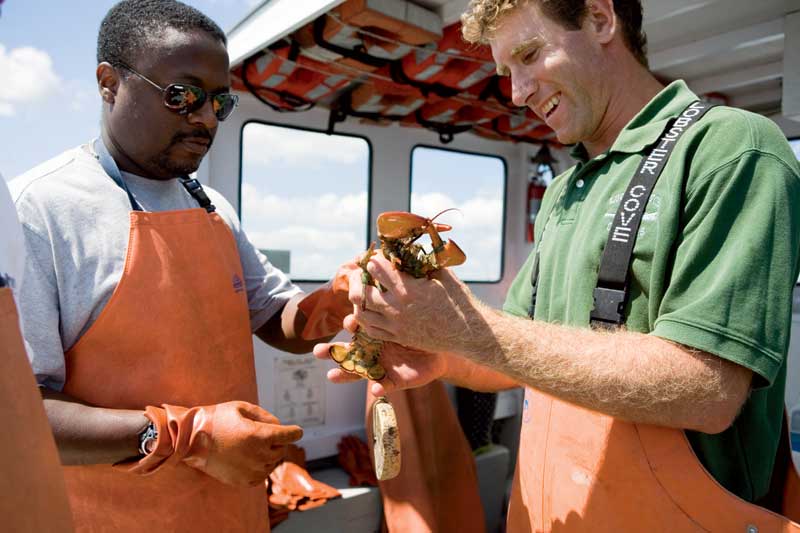After the Catch | Lobster Recipes
Nobody knows better than a Maine chef how to create delicious and affordable lobster dishes.

Chef Esau Crosby and Captain Tom Martin examine the catch.
Photo Credit : Dayton, SadieOn a summer morning, six Maine chefs and a lobsterman board Captain Tom Martin’s boat, the Lucky Catch, and set off on a voyage of discovery. Their goal: getting to know each other’s jobs–their limitations and struggles, as well as their satisfactions and joys. Maine lobster is the best in the world. “I catch ’em, you cook ’em, we all enjoy ’em,” Martin says as the Lucky Catch heads out from Portland Harbor into Casco Bay. “That’s what the Maine lifestyle is all about.” Together with Dane Somers, executive director of the Maine Lobster Council, Martin has invited the chefs along to see how it’s done.
Esau Crosby, whose culinary creations have graced the tables of Fore Street in Portland and Solo Bistro in Bath, among other venues, says he’s hoping for “a sea-to-table experience,” a chance for chefs to learn the realities of lobstering while providing culinary inspiration. “I want to see what’s going on in the industry, see it firsthand,” adds Trap Landry, formerly of Scarborough’s Black Point Inn and now chef at Lunetta in Brooklyn, New York. “[Maine restaurants] use a lot of lobster. It’s what people from away come for.”
The boat glides past Portland Breakwater Light, Spring Point Ledge Lighthouse, and then Fort Scammell, on the west side of House Island. Sunlight sparkles on the bay, and the group is chatty and relaxed. They share an interest in protecting and promoting lobster–but they also know that tensions among fishermen, dealers, and restaurateurs have been building. Catches have been bountiful, but lobster is still seen as a luxury food, and in a difficult economy, demand is lower. Fewer diners are ordering it, and even cruise ships have cut back.
Captain Martin hauls his first traps near Portland Head Light. The chefs don waterproof aprons and gloves to help out. The first trap contains two lobsters. One, an egg-bearing female, must be marked with a notch in its tail and returned to the sea. The other is just over the minimum limit. Using a special metal gauge, Martin shows how to measure the carapace: “It has to be at least 3-1/4 inches from the rear of the eye socket to the rear edge of the back–the main body shell–and not more than 5 inches, or it has to be thrown back,” to maintain a viable stock.
Together, the chefs put five small herring into each netted bait bag, add them to the traps, return them to the sea, and head for the next site. Here, one trap yields a huge lobster, nearly five pounds and just under the legal ceiling. Another trap contains nothing but a can of Mountain Dew, which is shaking vigorously. Suddenly, out pops a little rock eel, slithering across the deck.
Bryan Dame, of The Edge in Lincolnville, says he’s surprised that so much effort yields so few sellable lobsters. Not unusual, says Martin. “Get one keeper out of every trap and you’re doing good,” he says. And each fisherman is limited by law to no more than 600 to 800 traps, depending on location. The lobsterman today finds himself struggling, too, with economic realities beyond his control; he’s catching more, making less. The challenge for chefs, on the other hand, is to keep lobster on the menu, while creating interesting dishes and keeping prices reasonable.
Somers suggests that one solution for cost-conscious chefs is to capture the flavor of lobster but use it “as one ingredient in the dish, rather than using a whole lobster” per serving. “Lobster is rich in protein,” Landry agrees. “A little goes a long way.” After their trip, each chef designs a dish that uses lobster economically and–for Yankee readers–simply enough that home cooks can prepare it as well.
RECIPES:

